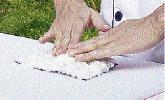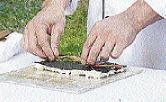Sushi Do-it-yourself tips from Japanese chef
Published: Saturday | January 24, 2009


The rainbow roll, specially prepared by Cocoro Restaurant chef Tomohisa Natsume. - Photos by Takahiro Sawada and Patrick James
Some Jamaicans shrink away at the thought of eating raw fish but developing an appetite for fine cuisine is easier than one might think. Today, staff at the Cocoro Japanese restaurant tell us how to make sushi and share dining dos and don'ts.
There are many, many kinds of sushi, either rolled or unrolled. A chef for more than 15 years, Tomohisa Natsume has been in Jamaica for four years. Natsume, the proprietor, explains the process of making two rolled sushi types - rainbow and Caribbean - and the unrolled sushi called nigiri.
For starters, the general elements needed are a bamboo mat covered with plastic wrap, uncovered bamboo mat, flattened dried seaweed, usually measuring 6-8 inches on either side, Japanese rice (rice with vinegar), choice of fillings, and sauces.
For the rainbow roll, Natsume chooses small, very thin slices of raw salmon, yellowtail, tuna and snapper. For the inside, he selects sliced avocado, sliced cucumber and crab sticks. Yum.
For the Caribbean roll, which somewhat resembles a California roll, he chooses cooked white fish, tomato, scallion, Japanese mayonnaise, sushi sauce, crunches, and sesame seeds. Concentrated teriyaki sauce is preferred.
It's important to have a towel/rag for ongoing cleansing of the fingers.
Making sushi
To begin, spread the dried seaweed on the table and, using the fingers, compress Japanese rice on to it, making sure to cover the seaweed entirely. The rice should measure approximately one centimetre in height. Afterwards, turn it over on to the bamboo mat already covered with plastic wrap. Add the filling vertically from only one side.
For the rainbow roll, the chefs add crab sticks, avocado and cucumber. Using the bamboo mat, roll this combination into a compressed roll, while squeezing the sides inwards to maintain neatness. The roll should now measure the length of the seaweed.
Open the mat to allow yourself access to add other items outside. For the rainbow roll, the chef adds thin slices of fish, salmon, shrimp, yellowtail and snapper. Plastic wrap should then be used to cover the roll without disturbing it. Gently pat the plastic wrap, then, using the bamboo mat, gently pat on all sides.
Remove the bamboo mat and further cut and divide the sushi into bite-size pieces. If you do it correctly, each piece will be about three-quarters of an inch to an inch long. Of course, you may decorate or garnish with herbs and sauces.
For all rolls, the process is the same. The difference lies in the ingredients for the filling. For the Caribbean roll, sesame seeds are first sprinkled on the seaweed before the rice is added. A streak of mayonnaise and fillings (tomato slice, scallion, white fish slice) are placed in a line and the sushi first rolled.
Afterwards, other ingredients can be inserted and the plastic wrap follows with a pat as above. The sushi is now ready to be cut and put on the sushi board for serving.
EATING
Unrolled sushi is very basic and easy to make. A ball of Japanese rice is placed in the palm, and gently compressed. The index and middle fingers of the other hand can be used to further compress the rice while it is spun in a circular motion in the palm.
Place your choice of fish kind such as a thin slice of salmon or pieces or parboiled shrimp on top and repeat the compression process. When you are satisfied that it won't fall apart, it's ready for serving. For some unrolled sushi, a band of seaweed is usually put around the middle before serving.
Japanese ginger and, sometimes, soy sauce are served with all kinds of sushi.
As concentrated sauce is already sprinkled all over the Caribbean sushi, no other sauce is necessary. However, chefs warn Jamaicans not to overindulge, as too much sauce ruins the taste and flavour of the sushi.
Assistant chef Mihoko Sinclair suggests that only the corner of the sushi needs to be dipped in the soy sauce bowl. Although some persons prefer to dip the rice side, she usually dips the fish end.
When dining, knives and forks are a last option. While the Japanese enjoy using their fingers to eat, the adventurous can use their chopsticks.
And, what advice does Takahiro Sawada, manager at Cocoro, have for sushi lovers? "Just enjoy (sushi) in your own style."

Cocoro Restaurant's chef, Tomohisa Natsume, presses Japanese rice on to dried seaweed.

Compressed Japanese rice on dried seaweed is turned over on to the bamboo mat, pre-wrapped with plastic, before the filling is added.

Natsume demonstrates how to add the sushi filling, in a vertical line, from one side to the other.

Using the bamboo mat, Natsume rolls the combination of rice and filling into a sushi roll.

Cocoro's assistant chef, Mihoko Sinclair, demonstrates how to hold chopsticks to pick up sushi. On display is Caribbean roll sushi. Inside the oke bowl are samples of unrolled sushi (nigiri).

Cocoro Restaurant's assistant chef, Mihoko Sinclair, shows her preferred way of dipping sushi in soy sauce with chopsticks.
Comments and questions are welcome at anthea.mcgibbon@gleanerjm.com or saturdaylife@gleanerjm.com.
